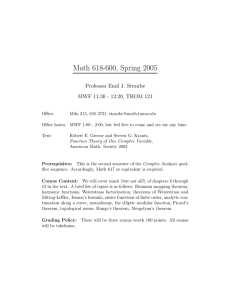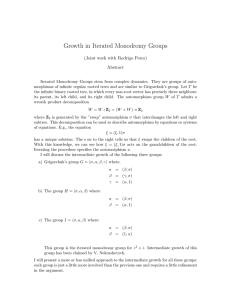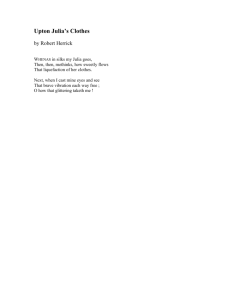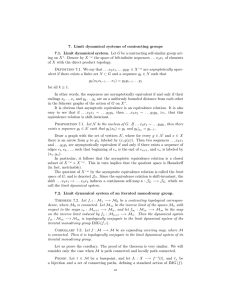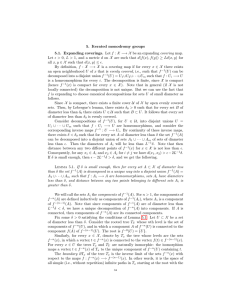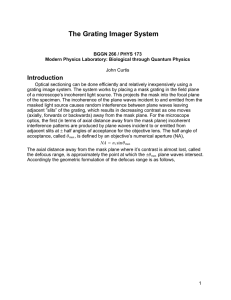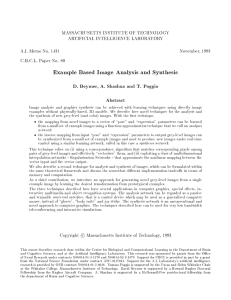Iterated monodromy groups Volodymyr Nekrashevych Gaeta, Italy May 31–June 6, 2003.
advertisement
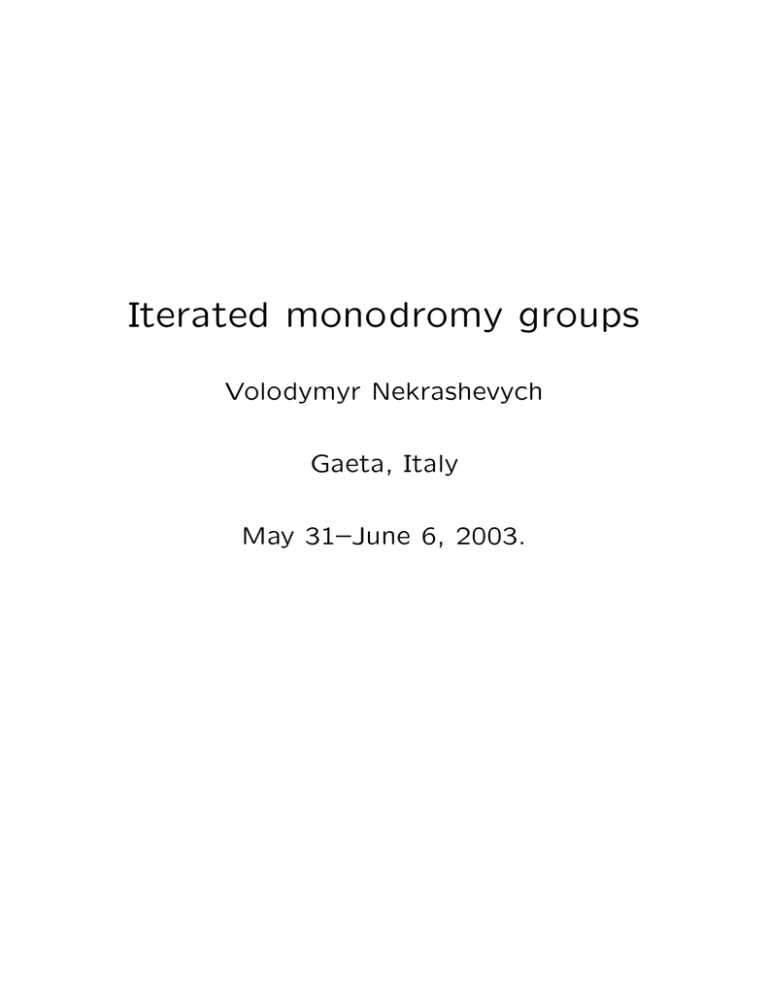
Iterated monodromy groups
Volodymyr Nekrashevych
Gaeta, Italy
May 31–June 6, 2003.
M — an arcwise connected and locally arcwise
connected topological space (or an orbispace)
M1 — its open arcwise connected subset (resp.
sub-orbispace).
f : M1 → M — a d-fold covering map.
t ∈ M — a basepoint.
f
f
f
t
f
···
f
f
f −1(t)
f −2(t)
f −3(t)
Preimage tree Tt.
1
···
t
γ
Iterated monodromy action.
The action on Tt is an action by automorphisms of the rooted tree.
Definition. The quotient of the fundamental
group π1(M, t) by the kernel of the action is
called the iterated monodromy group IMG (f )
of the covering f .
The group IMG (f ) and its action on the tree
Tt depends only on f .
2
Computation of IMG (f )
Choose an alphabet X, |X| = d, a bijection
Λ : X → f −1(t), and a path `x from t to Λ(x)
for every x ∈ X.
X ∗ is the rooted tree of finite words, where a
word v ∈ X ∗ is connected to vx, ∀x ∈ X.
Define the map Λ : X ∗ → Tt inductively by the
rule:
f −n (`x) 3
f −n (t) 3 Λ(v)
Λ(vx)
The map Λ : X ∗ → Tt is an isomorphism of
rooted trees.
3
The isomorphism Λ : X ∗ → Tt conjugates the
iterated monodromy action of π1(M, t) on Tt
to a self-similar action on X ∗ defined by the
formula
(xv )γ = y
`xγx `−1
y
v
,
where v ∈ X ∗, x ∈ X and
Λ(x)
`x
γx
t
γ
`y
Λ(y)
This is the standard action of IMG (f ) on X ∗.
4
Examples
1. f (z) = z 2 with M = C \ {0} and M1 = M.
Let X = {0 , 1 } and t = 1. The fundamental
group of M is generated by a single loop τ
around 0.
τ0
τ
Λ(1 )
t
Λ(0 )
τ1
We take `0 is trivial at t, `1 = τ0 .
Then
(0 v)τ = 1 v,
(1 v)τ = 0 v τ .
(0, 0)
(1, 0)
(0, 1)
(1, 1)
5
1. f (z) = z 2 − 1 with M = C \ {0, −1} and
M1 = C \ {0, −1, 1}.
√
Let t = 1−2 5 . The fundamental group of M
is generated by two loops a and b.
a
b
t
0
−1
`1
a1
b0
b1
1
a0
(0 v)a = 1 v b,
(1 v)a = 0 v
(0 v)b = 0 v a,
(1 v)b = 1 v.
6
Theorem. [R.
A. Żuk] The
Grigorchuk,
group G = IMG z 2 − 1
• is torsion free;
• has exponential growth;
• is just non-solvable;
• has solvable word and conjugacy problems;
• has no free subgroups.
Theorem. [L. Bartholdi]
G=
k+1
k+1
k
k
k
k
.
, a2
a, b a2 , b2 , b2 , b2 , a2
7
Limit spaces
Let (G, X ∗) be a self-similar contracting group
action. Denote by X −ω the space of all sequences
. . . x 3 x2 x1 ,
with the product topology.
xi ∈ X
. . . x2x1 ≈ . . . y2y1 if there exists a bounded sequence gn ∈ G such that
(xnxn−1 . . . x1)gn = (ynyn−1 . . . y1).
X −ω / ≈ is the limit space JG.
The shift . . . x3x2x1 7→ . . . x4x3x2 induces a continuous map s : JG → JG. We get the limit
dynamical system (JG, s).
The space JG has a natural structure of an
orbispace such that s is a |X|-fold covering by
an open sub-orbispace of JG.
8
Theorem 1. Let f : M1 → M be an expanding covering. Then the standard action of
IMG (f ) on X ∗ is contracting and the restriction
of f onto its Julia set is topologically conjugate
to the limit dynamical system (JG, s).
An example. The Julia set of z 2 is the unit
circle, and z 2 acts on it as a double covering. The automaton generating the adding
machine action generates the equivalence relation:
. . . 0001 xn xn−1 . . . x1 ≈ . . . 1110 xn xn−1 . . . x1
. . . 0000 ≈ 1111 ,
i.e., the limit space is the circle R/Z and the
map s is induced by x 7→ 2x.
b → C
b is
In general, if a rational function f : C
sub-hyperbolic, then f is expanding on a neighborhood of the Julia set. (Orbispaces have to
be used in many cases!)
9
We get finite-to-one encodings of the Julia set
by sequences. They are finite presentations of
the respective dynamical systems.
For example, the Julia set of the polynomial
z 2 − 1 is the quotient of the space {0 , 1 }−ω by
the equivalence relation
. . . 0000001 v ≈ . . . 0101011 v ≈ . . . 1010100 v
. . . 0000 ≈ . . . 0101 ≈ . . . 1010
The Schreier graphs Γn of the action of the
group IMG (f ) on the sets X n approximate the
Julia set of f .
10
a b a
a
a
b a
a
11
z2 + i
10
01
00
12
The following is an analog of theorems by
M. Shub, J. Franks and M. Gromov and can
be proved using Theorem 1 and M. Gromov’s
theorem on groups of polynomial groups.
Theorem 2. Let f : M → M be an expanding finite self-covering of a compact orbifold. Then there exists a nilpotent simplyconnected Lie group L, a proper affine action
of G = π1(M) on L and an expanding automorphism φ : L → L such that M = G\L,
φ · G · φ−1 < G and φ induces f .
IMG (f ) = π1(M) and is virtually nilpotent.
(JIMG(f ) , s) is topologically conjugate to (M, f ).
The encoding of the points of M by sequences
generalize the numeration systems on R: the
sequence . . . x2x1 corresponds to the point
· · · φ−2(rx3 )φ−1(rx2 )rx1 ∈ L
where rx ∈ L are “digits”, indexed by x ∈ X.
13
Digit tile T is the set of elements
· · · φ−2(rx3 )φ−1(rx2 )rx1 ∈ L
for all possible sequences . . . x2x1 ∈ X −ω .
Some examples of digit tiles in R2:
14

